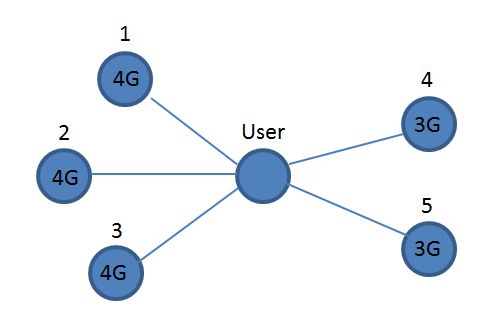A social networking game for buying a 4G phone
Technology seems to advance faster and faster as companies struggle to compete in bloated technology markets for PCs, mobile phones, tablets, and other consumer technologies. Shoppers not only have to choose what product to buy, but also when to indulge in new technologies. Is it really worth purchasing a phone or computer that will be technologically surpassed so quickly? In particular, the mobile phone market has been making impressive advances not only in consumer-end hardware and software technology, but also in wireless protocols and data speeds. Wireless carriers not only struggle with huge increases in data transmissions, but also with competition for transfer speeds between networks. So when networks and handheld devices are constantly updated, when should consumers purchase new technology?
We can model the program as a social network game, where a user has possible connections between multiple cell phone carriers and technologies. The two prominent wireless technologies available today are the 3G and 4G LTE technologies. However, both technologies aren’t always available in all areas. Cell phone carriers have been working hard and investing heavily to bring the newest wireless technologies to more customers, but at this point, not all wireless carriers have 4g technology in all areas. So, if a user knows their primary cell phone usage is in five particular regions they have to consider the number of towers with 4G technology. The user has an opportunity to either buy a 4G or 3G handset, but the 4G headset will only work at slower 3G speeds if in a 3G area. Therefore, the user wants to coordinate with their neighboring nodes, which in this case are cell phone towers. An illustrated graph is shown below:
Wireless companies have the option to upgrade each tower to 4G LTE technology or leave the 3G technology in place. So what we have is a coordination game between the user and each cell tower. The cellular providers don’t want to update to 4G technology if users won’t upgrade their handsets anyway, and cellular users don’t want to buy a brand new faster handset if it only can work with 3G towers. The payoff for the user is the added payoffs from each tower that they use. If a fraction p of the towers choose 4G technology, and a fraction (1-p) choose 3G, and the user has n neighboring towers, the total payoff is (p x n x the payoff of 4G technology) + ((1-p) x n x the payoff of 3G technology). The user will choose the technology based on which payoff is greater. With this in mind, we can algebraically determine that the user will choose to buy a 4G headset if p is greater than the payoff for 3G technology divided by the payoffs of the two technologies added together. Of course, the payoffs for each technology are only based on the opinions of each user, but if these opinions are quantified, the choice of whether or not to purchase a 4G LTE headset can be easily modeled.
– Castor Troy
Sources: http://www.pcmag.com/article2/0,2817,2399984,00.asp
http://www.pcmag.com/article2/0,2817,2411936,00.asp
http://www.forbes.com/sites/halsinger/2012/10/19/are-4g-lte-prices-in-the-united-states-too-high/
http://www.technobloom.com/att-investing-billions-in-upgrades-to-4g-lte-network/2219040/

